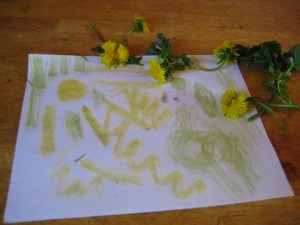There’s a chemical which is found in every green plant–every tree, grass blade, bush, cactus, moss, rosebush, lettuce, whatever. It’s called chlorophyll, and it’s a pigment, actually, a green pigment which absorbs just the right wavelength of sunlight to jumpstart the complex chemical process whereby plants make food. Chlorophyll is the key to photosynthesis, enabling plants to magically transform air, sunlight, and water into sugars that nourish the plant and anything that eats it. Chlorophyll is, really, the basis of life on this planet.
Chlorophyll is also the stuff that puts grass stains on the knees of your pants. It’s a pigment, remember, which is basically paint. It’s the reason all those plants all over the world are green and not pink or blue or purple. And it occurs to me one day, as I’m fruitlessly trying to scrub the indelible grass stains from my favorite jeans—could this remarkably persistent green coloring be somehow used as an art material?
So I try it. A handful of clover and dandelion leaves, rubbed firmly on white paper, leave a startlingly bright green stripe. Nature’s crayon.
Hm. This is sort of fun. I experiment with other wild pigments. Yellow dandelion flowers give a sunny yellow stripe. Raspberries yield psychedelic purple. Wild grapes are rich plum color. Catnip leaves give a brilliant green. Blueberries are disappointing, though–just beige goop. Haven’t experimented with apples yet.
Why, you may ask, is this entertaining but trivial idea so important, worthy of a blog post? Because, for children these days, nature is something you Just Don’t Touch. During nature walks, when I ask students what they think the most important rule of the outdoors* is, they one and all chorus “Don’t touch anything!!!”
Think about it—wasn’t that the rule on every field trip you ever went on? You see with your eyes, boys and girls. Please don’t touch!
But kids need to touch the real world. They need to pick grass blades, and fool around with dandelions, and count the petals on daisies to discover if he loves me or he loves me not. They need to get their fingers stained with wild grapes and raspberries and get wet and muddy and grass-stained.
Thing is, it’s getting harder to persuade kids to do these things. Fear of germs, ticks, rabies, germs, strangers, germs…kids don’t mess around much with nature any more. But there’s something about crayons that no kid can resist.
So, parents, grandparents, aunts and uncles, camp counselors and babysitters: this summer, give it a try. On some rainy day. Or during a dull picnic, when the kids are whining to go indoors so they can recharge their cell phones. Get a big sheet of paper. Grab some clover and dandelion leaves, and paint that chlorophyll all over the place. Pick some dandelions, and scribble bold yellow suns. Experiment with some other colors, too—purple lilacs, red tulip petals, orange day lilies and marigolds. There’s a whole Crayola box out there along the trails and in the gardens. 
**The most important rule of the outdoors is: show respect to all living things.





We don’t have any kind of flowers & vegetable plants.
Makes me excited to try it! Thanks for another eye-opening post.
Ok.
We don’t have any kind of flowers and vegetable plants.